DHSC: gender pay gap report and data 2020
Published 15 December 2020
Applies to England
Introduction
In 2017, the government introduced world-leading legislation that made it statutory for organisations with 250 or more employees to report annually on their gender pay gap. Government departments are also covered by the Equality Act 2010 (Specific Duties and Public Authorities) Regulations 2017 which came into force on 31 March 2017. These regulations underpin the Public Sector Equality Duty and require relevant organisations to publish their gender pay gap by 30 March annually. This includes the mean and median gender pay gaps; the mean and median gender bonus gaps; the proportion of men and women who received bonuses; and the proportions of male and female employees in each pay quartile.
This report fulfils the department and its executive agencies reporting requirements, analyses the figures in more detail and sets out what we are doing to reduce the gender pay gap. The reporting period is 1 April 2019 to 31 March 2020.
The Department of Health and Social Care is formed of the core Department (DHSC) and its executive agencies, Public Health England (PHE), and the Medicines and Healthcare Products Regulatory Agency (MHRA). The individual organisations hold the responsibility of analysing their reward mechanisms (such as pay and bonuses) to assure themselves that there is no gender bias.
The department and its executive agencies is committed to the fair treatment and reward of all staff and addressing inequality. The department and its executive agencies pay approach is based on the principles of consistency, fairness and transparency, supporting the fair treatment and reward of all staff irrespective of gender.
Building a diverse and inclusive workforce that reflects the people we serve is one of the Civil Service’s top workforce priorities. The Civil Service should create opportunities for all in a truly meritocratic way and reward all civil servants fairly, regardless of gender, ethnicity or any other personal characteristic.
Gender pay gap report
The gender pay gap shows the difference in the average pay between all men and women in a workforce. If a workforce has a particularly high gender pay gap, this can indicate that there may be a number of issues to deal with and the individual calculations may help to identify what those issues are.
The gender pay gap is different to equal pay. Equal pay deals with the pay differences between men and women who carry out the same jobs, similar jobs or work of equal value. It is unlawful to pay people unequally because they are a man or a woman.
For this report, hourly pay is calculated using base pay, allowances, and bonuses paid in the relevant pay period as defined in the regulations.
Below are our 2020 gender pay gap figures. ‘Health and Social Care’ refers to the overall figures from DHSC, PHE and MHRA.
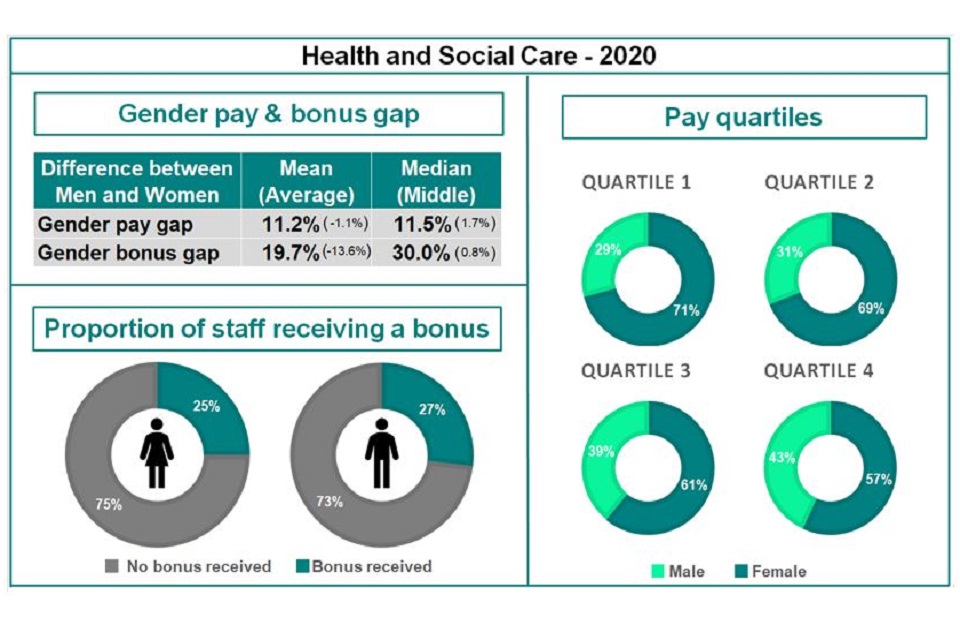
2020 Health and Social Care gender pay/bonus gap figures, showing reductions of the mean pay/bonus gaps, and increased median pay/bonus gaps. Full data can be found in ‘Table C – Gender Pay Gap Statistics’ at Civil Service statistics: 2020.
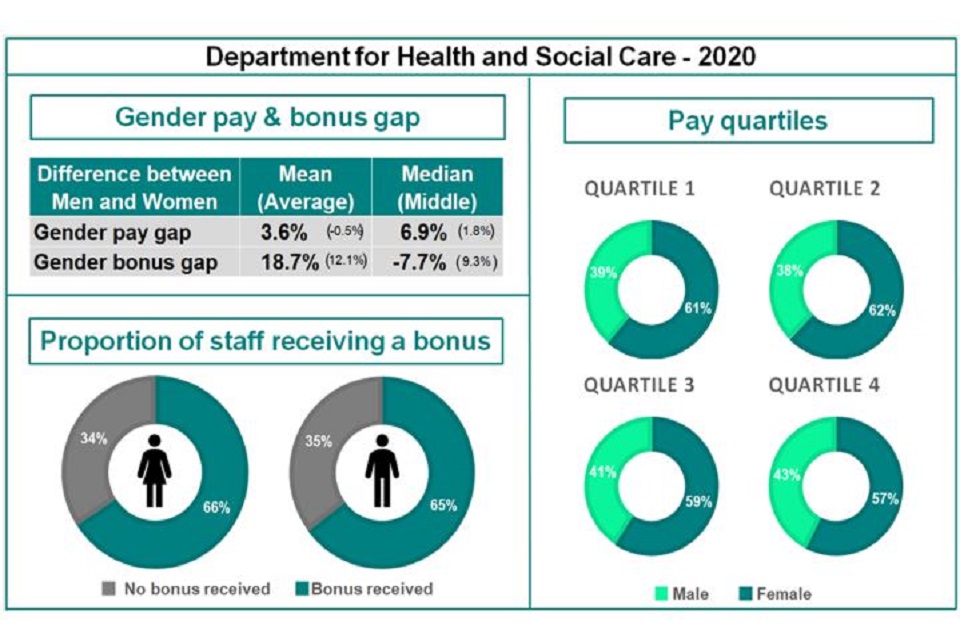
2020 Department of Health and Social Care gender pay/bonus gap figures, showing reductions of the mean pay, and increased median pay/bonus gaps and mean bonus gap. Full data can be found in ‘Table C – Gender Pay Gap Statistics’ at Civil Service statistics: 2020.
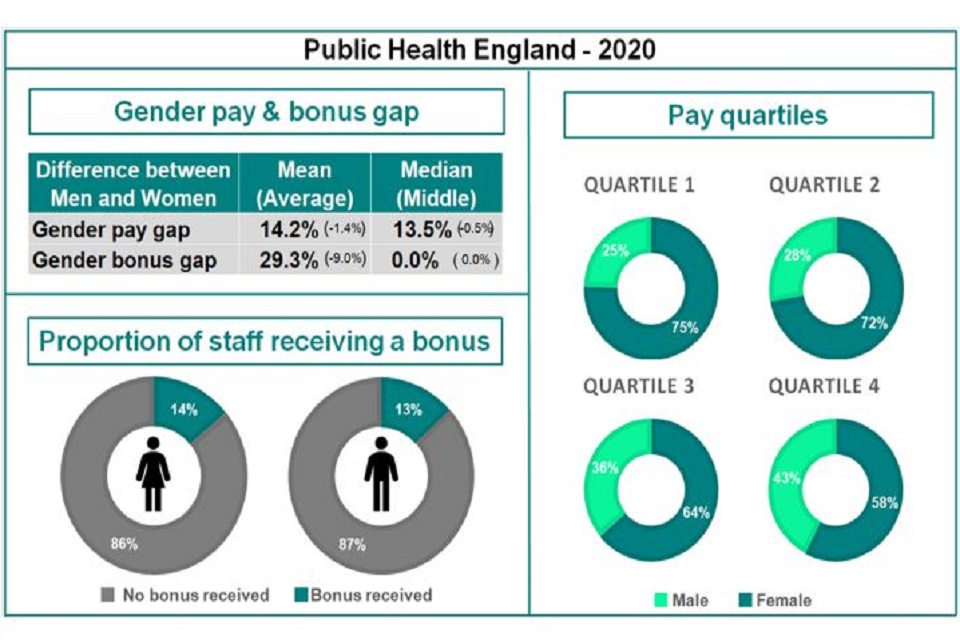
2020 Public Health England gender pay/bonus gap figures, showing reductions of the mean and median pay and the mean bonus gap. The median bonus gap remains the same. Full data can be found in ‘Table C – Gender Pay Gap Statistics’ at Civil Service statistics: 2020.
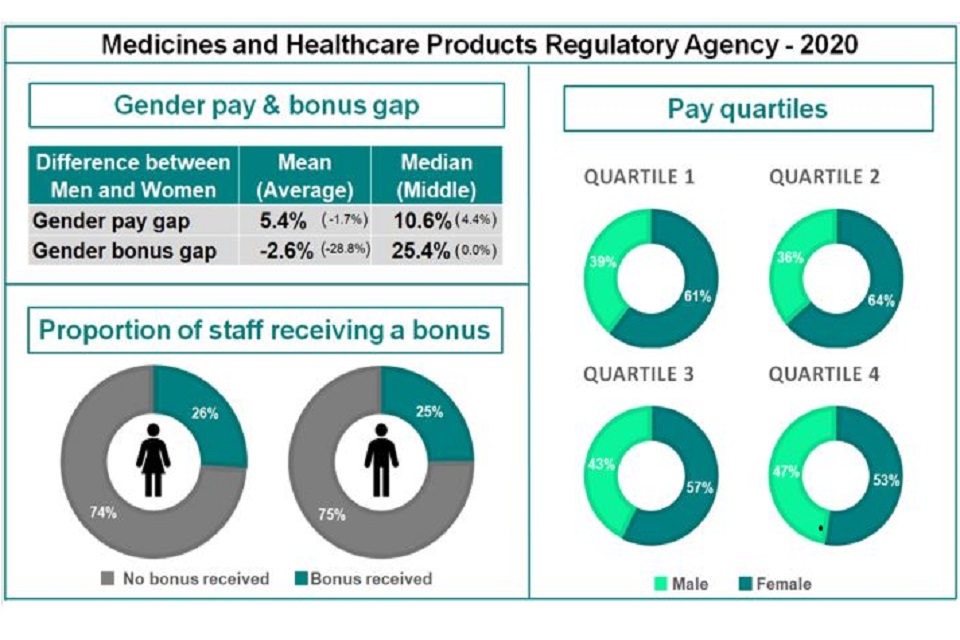
2020 Medicines and Healthcare Products Regulatory Agency gender pay/bonus gap figures, showing reductions of the mean pay/bonus gaps, and increased median pay. The median bonus gap remains unchanged. Full data can be found in ‘Table C – Gender Pay Gap Statistics’ at Civil Service statistics: 2020.
The pay gap
The department and its executive agencies is structured using Civil Service grades ranging from administrative assistant to the Senior Civil Service. Grades reflect levels of responsibility and each grade has a set pay range. Staff normally receive pay rises annually or receive pay increases upon promotion or temporary promotion.
For the department and its executive agencies collectively, the mean pay gap continues to reduce. The current pay gap is 11.2%. This is a 1.1% reduction from 2019 and a 2.2% reduction from 2017. We’re pleased to see this figure continue to fall as it represents the difference in average earnings between men and women.
The median pay gap has increased from 2019 to 11.5%. This is a 1.7% increase from last year. However, this is still lower than our original 2017 figure of 13.3%. Our figure remains significantly lower than the national average. We will continue to monitor this closely.
The difference in hourly pay is driven by a number of factors including:
-
the higher proportion of men in the Senior Civil Service (SCS) compared to the overall population, and the higher pay / bonus opportunity in the SCS
-
this is compounded by the high proportion of women in the most junior grades
-
and finally, specific very senior roles can have a disproportionate impact on the pay gap. During the reporting year DHSC appointed a new male Chief Medical Officer, replacing the previous female incumbent
| Grade (decreasing seniority) | Number of men (% of men who work in this grade) | Number of women (% of women who work in this grade) | % of women in the grade |
|---|---|---|---|
| SCS | 315 (10%) | 347 (7%) | 52% |
| Grade 6/7 | 1094 (34%) | 1496 (28%) | 58% |
| SEO/HEO | 1196 (37%) | 2024 (38%) | 63% |
| EO | 374 (12%) | 814 (15%) | 69% |
| AA/AO | 228 (7%) | 613 (12%) | 73% |
| Total | 3207 | 5294 | 62% |
Please note: The PHE workforce comprises of different staff groups on different sets of terms and conditions and on different pay scales and arrangements. While the majority (circa 75%) of the PHE workforce fall under the standard Civil Service pay arrangements and grade framework the remaining workforce are paid against the NHS (Agenda for Change and Medical and Dental) pay frameworks. PHE also has a number of colleagues on Medical and Dental terms and conditions which also attracts additional premium. Whilst the entire workforce is covered under the PHE gender pay gap figure the range of different pay arrangements results in a more complex relationship impacting on the gender pay gap figure.
Proportion of males and females in each pay quartile
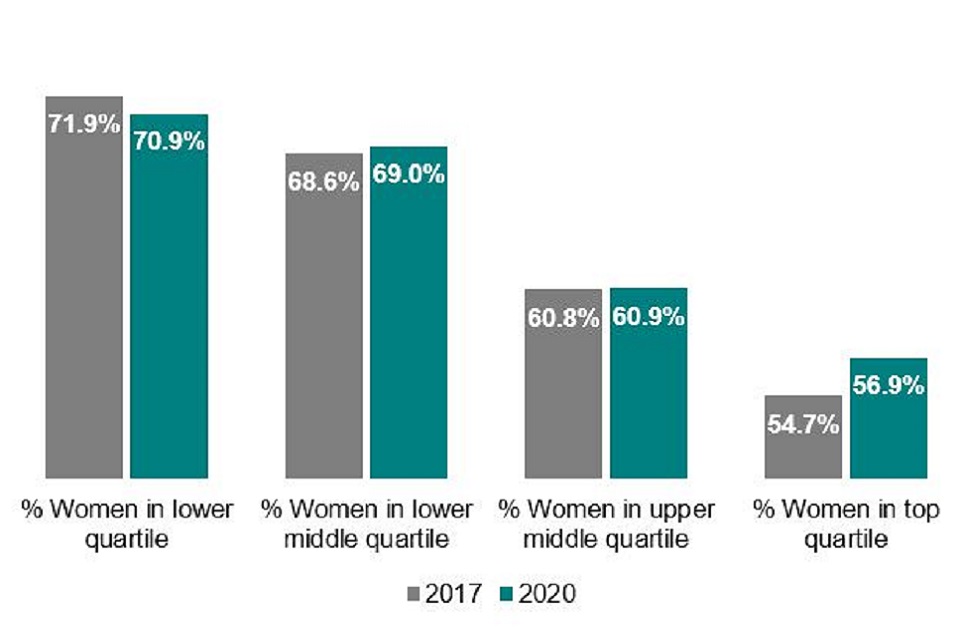
70.9% of colleagues in the lower quartile are female, compared to 56.9% in the upper quartile. The disproportional male distribution is one of the factors driving the gender pay and bonus gaps. It has more of an impact on the bonus figure, as at the most senior levels there is more bonus opportunity and the level of bonus is considerably higher.
Since 2017 we have made progress in improving this distribution, especially progressing more women into the top quartile. Addressing this is a slow process, but one we are committed to. We’re pleased to report that compared to 2019, 0.9% more women are in the top quartile.
The bonus gap
In the DHSC and its executive agencies, performance awards were paid as a set value depending on grade and performance.
The bonus pay gap is driven by the availability of higher bonuses in the most senior grades where the proportion of men is not in line with the overall population.
For the department and its executive agencies, the mean bonus gap has reduced to 19.7%, a reduction of 13.6% from in 2019 and by 13.4% from 2017. This shows a large reduction in difference between the average bonuses men and women receive.
The median bonus gap has increased to 30% in 2020. This is a 0.8% increase from 2019, but a 19.6% increase from 2017. While only a small increase from 2019 we recognise our median bonus gap is substantial, and we are committed to working with our Agencies to address this.
For 2020 to 2021 DHSC has removed its end-year bonus scheme for staff below the SCS, in favour of an in-year reward scheme. The scheme aims to spread financial recognition to a wider population. The schemes performance over its first year will be monitored closely to ensure consistency and fairness of awards.
Targeted action to reduce the gender pay gap
The department and its executive agencies remain committed to addressing the gender pay gap. Below outlines our action plan to reduce the pay gap.
Ensuring the fairness and equality of recruitment
Continuing to review our recruitment policies and processes to ensure fairness and equality, while monitoring the effectiveness of the newly implemented Civil Service Success Profiles. This includes ensuring diversity of interview panels and scrutinising the recruitment journey from job posting through to job offer, which offers insight into the demographics of applicants at each stage of the process. This is to ensure we have confidence in the fairness of our recruitment processes and to enable us to recruit from the widest pool of applicants possible and to ensure we recruit the best person for the role regardless of gender.
Talent, progression and career paths
Continued focus on improving representation of female participants on internal talent schemes, and additional gender-focused schemes at the senior levels. The department and its executive agencies will continue to promote applications for the Future Leaders Scheme and Senior Leaders Scheme, while also supporting and developing internal mentoring and reverse mentoring schemes. With the aim to ensure women are supported and developed to take full advantage of the opportunities available to support their progression and associated opportunities to increase their salaries by gaining promotion.
Diversity and inclusion strategy
The department and agencies continue to strive to create an inclusive culture in which everyone has equal opportunity to achieve their potential, fitting of a world-class healthcare system. Gender equality remains an integral element of our diversity and inclusion strategies. PHE is improving its internal transparency on the work to reduce the gender pay gap, to enable managers and staff to help shape the strategy and share responsibility for making progress across the agency. This includes modelling and forecasting to understand how and where closures in the gap can be made.
Use of effective pay strategies
DHSC core continues its approach of focusing pay increases at the lower half of the pay scales, which proportionally is made up of more female staff, to drive progression through the pay system. Additionally, DHSC core has removed its end-year bonus scheme, moving to a purely in-year reward and recognition scheme. This aims to increases the fairness of awards and consistency across protected groups within the department. MHRA are similarly addressing the distribution of their bonuses by developing a new performance management scheme and improving the process for pay business cases supported by equality impact assessments. PHE has followed its strategic aim of increasing the pay for the lowest paid and for those in the lower end of each pay range, shortening pay ranges and reducing differentials.
Policies focused on supporting equality in the workplace
In response to COVID-19 the department and its executive agencies have adopted a widespread working from home model, which has progressed the flexible working agenda and provided evidence of its viability as an effective working model. This increased uptake has reinforced the importance of the use of the flexible working and home working policies support working models that are fair, consistent and inclusive and allow all staff to balance work and home and be able to progress their careers should they wish to.
The department and its agencies continue to support and promote family-friendly policies, such as shared parental leave, and monitor their uptake as a direct enabler for staff with caring responsibilities to be able to progress their career. This is supported by specific initiative and over 2020 to 2021, PHE will be rolling out training for all staff that includes a core element on diversity and inclusion to ensure a consistent approach is taken across the agency. PHE will continue to ensure its policies support equality. For example, it currently provides workplace adjustments guidance for the menopause. DHSC will be working to increase the support given for those returning to work from maternity leave.
PHE has recently had its Disability Confident Leader status renewed for a further 3 years. Further, PHE remains a Working Families Employer Member and a top-30 employer for working families.
